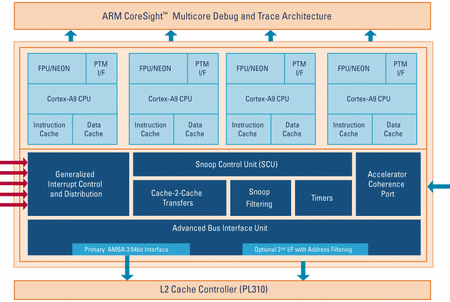ARM tipped for netbooks
Oct 24, 2008 — by LinuxDevices Staff — from the LinuxDevices Archive — 1 viewsNetbooks using ARM's high-end “Cortex-A” family of processor cores will begin appearing soon in netbooks, an ARM executive is reported as saying. Rob Coombs, ARM's director of mobile solutions, says to “expect announcements in the next few months,” as quoted by ZDNet UK.
The netbook category was, of course, christened by ARM's chief rival, Intel, which coined the moniker for low-cost sub-notebooks that use low-powered x86 processors such as the A110 or Atom. Future “netbooks” based on ARM cores would run on Linux, Windows Mobile, or Windows CE, but not Windows XP or Vista, unless Microsoft chose to port to the architecture. Meanwhile, the market for smaller MIDs (mobile Internet devices) will be dominated by ARM, despite Atom and other new lower-powered x86 processors, according to a June report on the MID market from Forward Concepts.
“In the future, we're going to be in netbooks,” Coombs is reported as saying. Products, which may offer “gigahertz speeds,” will be based first on ARM's Cortex-A8 processor, and later on the company's multicore Cortex-A9, Coombs is said to have added.
According to ZDnet.co.uk writer David Meyer, Coombs did not name any manufacturers who are preparing to release Cortex netbooks, instead referencing ARM's published list of licensees. Chipmakers licensed to produce Cortex-A9 CPUs are NEC, Nvidia, STmicroelectronics, Texas Instruments, and Toshiba, ARM says. Meanwhile, those licensed to produce Cortex-A8 products are Broadcom, Freescale, Matsushita, Samsung, STMicroelectronics, Texas Instruments, and PMC-Sierra, adds ARM.
 Nvidia's Tegra APX2500 (Click image for further information) |
Out of the above, Nvidia may be the likeliest candidate to extend Cortex technology into netbooks, since it has already started combining its notebook graphics processors with ARM cores, in SoCs aimed at the “mobile” market. The chipmaker in February launched the 600MHz Tegra APX2500, following up in June with the 700MHz Tegra 600 and 800MHz Tegra 650, the latter touted as supporting display resolutions up to 1680 x 1050. None of the Tegras, however, currently supports Linux.
The Cortex-A8, first announced in October 2005, has a superscalar architecture theoretically capable of dispatching two to three times more instructions per cycle than ARM11, while power consumption is no greater, claims ARM. Earlier this year, Texas Instruments (TI) launched a bevy of Cortex-A8 processors, including the OMAP3440, aimed at mobile phones, and the OMAP35xx, which is said to target “Internet appliances” and PMPs (portable media players). The top model in the latter family, the OMAP3530, is said to decode HD video at 30 frames per second, and also sports an OpenGL ES 2.0 graphics accelerator, TI says.

ARM Cortex-A9 in MPCore configuration
(Click to enlarge)
In 2007, ARM announced the multicore-enabled Cortex-A9, which, thanks to MPCore interconnect technology (above), is claimed to support SoC (system on chip designs) with up to four A9 cores. The Cortex-A9 will offer clock speeds over 1GHz, and will provide “four to 16 times the performance” of ARM11 while still fitting within the same power envelope, says ARM.
Availability
To read ZDNet.co.uk's story regarding ARM netbooks, see here. To review LinuxDevices Linux-powered netbook showcase, go here.
This article was originally published on LinuxDevices.com and has been donated to the open source community by QuinStreet Inc. Please visit LinuxToday.com for up-to-date news and articles about Linux and open source.